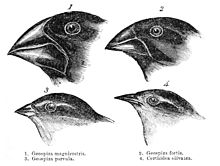Darwin Finch
| Darwin's finches | |
|---|---|
 |
|
|
Large ground finch, Medium ground finch Small tree finch, Green warbler-finch |
|
| Scientific classification | |
| Kingdom: | Animalia |
| Phylum: | Chordata |
| Class: | Aves |
| Order: | Passeriformes |
| Family: | Thraupidae |
| Genera | |
|
Geospiza |
|
Geospiza
Camarhynchus/Platyspiza
Certhidea
Pinaroloxias
Darwin's finches (also known as the Galápagos finches) are a group of about fifteenspecies of passerine birds. They are well known for their remarkable diversity in beak form and function. They are often classified as the subfamily Geospizinae or tribe Geospizini. They belong to the tanager family and are not closely related to the true finches. The closest known relative of the Galápagos finches is Tiaris obscura. They were first collected by Charles Darwin on the Galápagos Islands during the second voyage of the Beagle. Apart from the Cocos finch, which is from Cocos Island, the others are found only on the Galápagos Islands.
The term "Darwin's finches" was first applied by Percy Lowe in 1936, and popularised in 1947 by David Lack in his book Darwin's Finches. David Lack based his analysis on the large collection of museum specimens collected by the 1905–06 Galápagos expedition of the California Academy of Sciences, to whom Lack dedicated his 1947 book. The birds vary in size from 10 to 20 cm and weigh between 8 and 38 grams. The smallest are the warbler-finches and the largest is the vegetarian finch. The most important differences between species are in the size and shape of their beaks, which are highly adapted to different food sources. The birds are all dull-coloured.
...
Wikipedia
